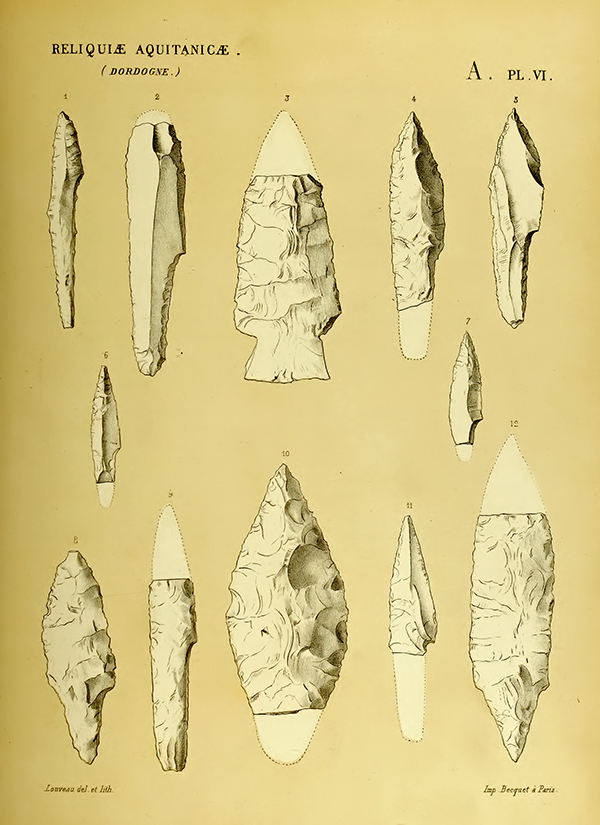Back to Don's Maps
 Back to Archaeological Sites
Back to Archaeological Sites
Laugerie Haute Tools
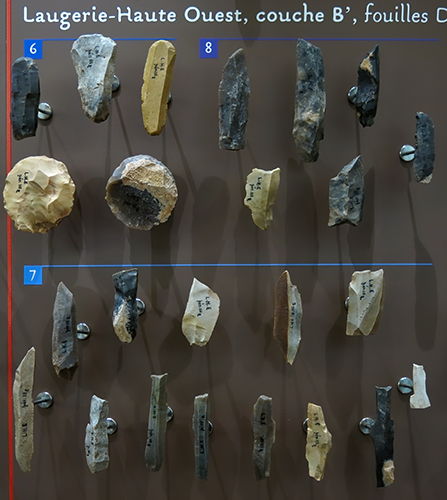
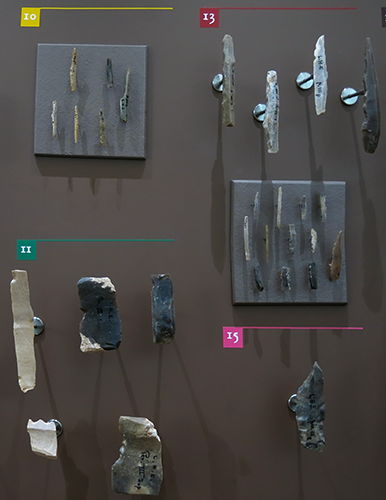
Note that the display for this group of tools indicates that they are from Laugerie Haute Ouest, Layer B', but all the tools are marked as coming from Laugerie Haute Est, Perigordian III.
From the excavations of D. Peyrony.
■ 6: Grattoirs, scrapers on the end of a blade
■ 7: Burins
■ 8: Retouched tools
■ 10: Microliths
■ 11: Notched/denticulated tools
■ 13: Armatures, tools
■ 15: Special tools
Photo: Don Hitchcock 2014
Source: Originals , Le Musée National de Préhistoire, Les Eyzies-de-Tayac
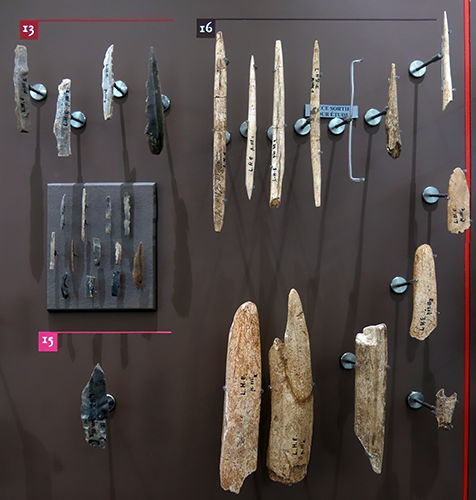
Note that the display for this group of tools indicates that they are from Laugerie Haute Ouest, Layer B', but all the tools are marked as coming from Laugerie Haute Est, Perigordian III.
■ 13: Armatures, tools
■ 15: Special tools
■ 16: Bone industry
Photo: Don Hitchcock 2014
Source: Originals , Le Musée National de Préhistoire, Les Eyzies-de-Tayac
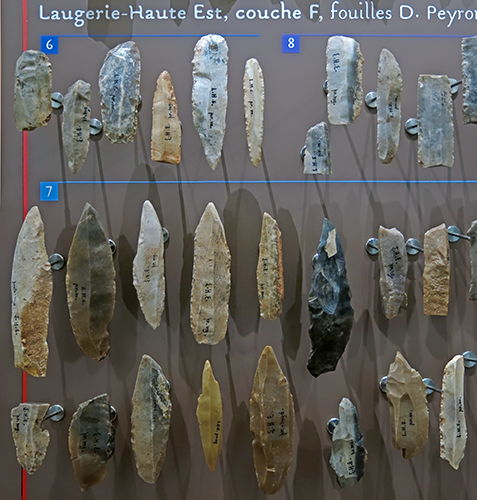
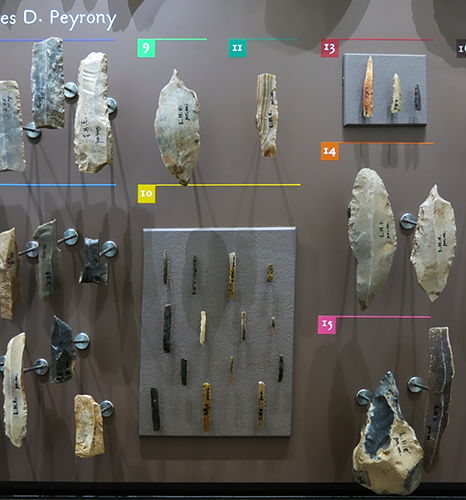
Laugerie Haute Est, Layer F, 23 000 BP.
Note that the tools are marked variously as L.H.E. pr-m, pr-mg, pr-mgd, that is as Proto Magdalenian.
■ 6: Grattoirs, scrapers on the end of a blade
■ 7: Burins
■ 8: Retouched tools
■ 9: Perçoirs becs, drills/borers
■ 10: Microliths
■ 11: Notched/denticulated tools
■ 13: Armatures, tools
■ 14: Composite tools
■ 15: Special tools
Photo: Don Hitchcock 2014
Source: Originals , Le Musée National de Préhistoire, Les Eyzies-de-Tayac
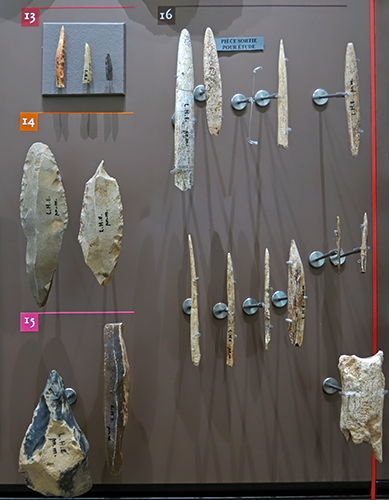
Laugerie Haute Est, Layer F, 23 000 BP.
Note that the tools are marked variously as L.H.E. pr-m, pr-mg, pr-mgd.
■ 13: Armatures, tools
■ 14: Composite tools
■ 15: Special tools
■ 16: Bone industry
Photo: Don Hitchcock 2014
Source: Originals , Le Musée National de Préhistoire, Les Eyzies-de-Tayac
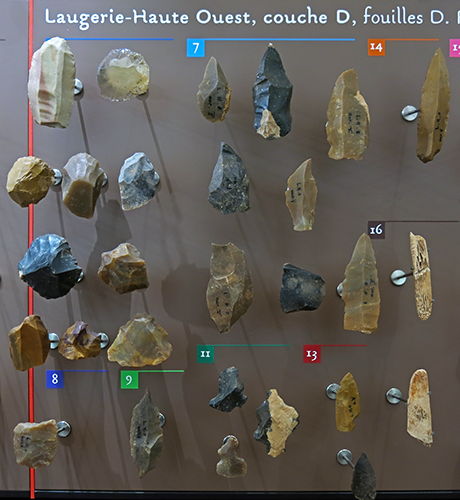
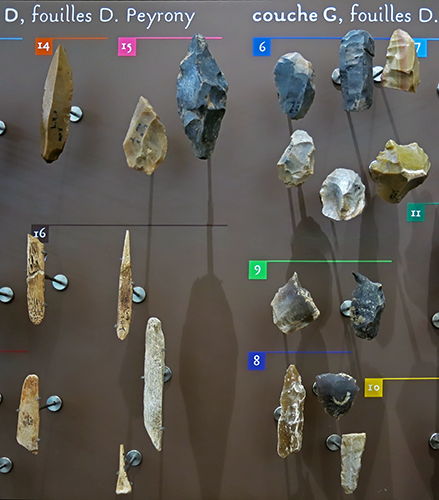
Laugerie Haute Ouest, layer D and G. Bed D is 22 000 BP.
Many of the tools are labelled as being Aur. V, or as Pro. Sol., that is as Aurignacian V or as Proto Solutrean.
■ 6: Grattoirs, scrapers on the end of a blade
■ 7: Burins
■ 8: Retouched tools
■ 9: Perçoirs becs, drills/borers
■ 10: Microliths
■ 11: Notched/denticulated tools
■ 13: Armatures, tools
■ 14: Composite tools
■ 15: Special tools
■ 16: Bone industry
Photo: Don Hitchcock 2014
Source: Originals , Le Musée National de Préhistoire, Les Eyzies-de-Tayac
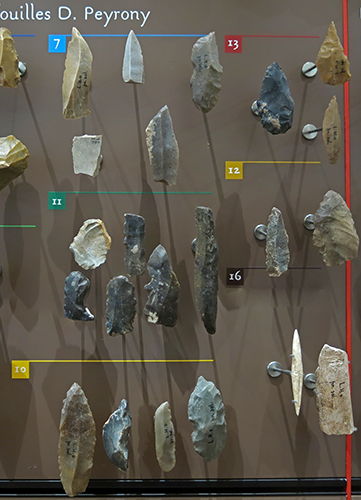
Laugerie Haute Ouest, layer G.
Many of the tools are labelled as being Pr. Sol., that is as Proto Solutrean.
■ 7: Burins
■ 10: Microliths
■ 11: Notched/denticulated tools
■ 12: Racloirs/raclettes, side scrapers and small, often round scrapers
■ 13: Armatures, tools
■ 16: Bone industry
Photo: Don Hitchcock 2014
Source: Originals , Le Musée National de Préhistoire, Les Eyzies-de-Tayac
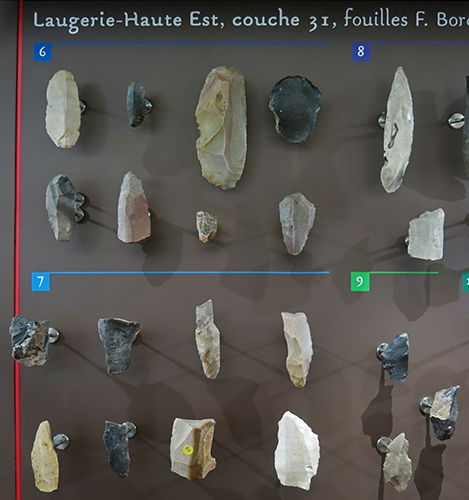
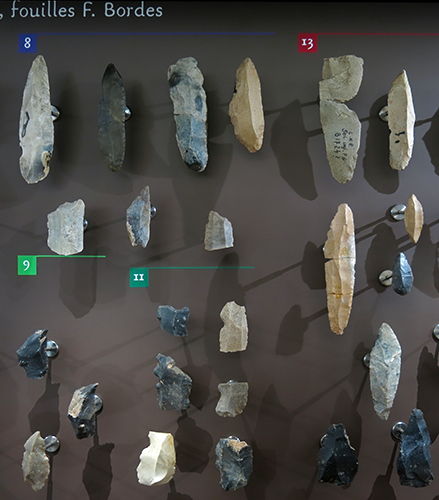
Laugerie Haute Est Layer 31, excavations of F. Bordes.
One of the tools bears the inscription L.H.E. Sol. inf., or lower Solutrean from Laugerie Haute Est.
■ 6: Grattoirs, scrapers on the end of a blade
■ 7: Burins
■ 8: Retouched tools
■ 9: Perçoirs becs, drills/borers
■ 11: Notched/denticulated tools
■ 13: Armatures, tools
Photo: Don Hitchcock 2014
Source: Originals , Le Musée National de Préhistoire, Les Eyzies-de-Tayac
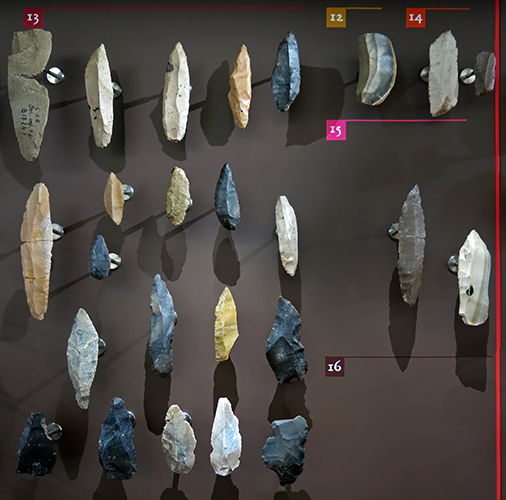
Laugerie Haute Est Layer 31, excavations of F. Bordes.
One of the tools bears the inscription L..H.E. Sol. inf., or lower Solutrean from Laugerie Haute Est.
■ 12: Racloirs/raclettes, side scrapers and small, often round scrapers
■ 13: Armatures, tools
■ 14: Composite tools
■ 15: Special tools
■ 16: Bone industry
Photo: Don Hitchcock 2014
Source: Originals , Le Musée National de Préhistoire, Les Eyzies-de-Tayac
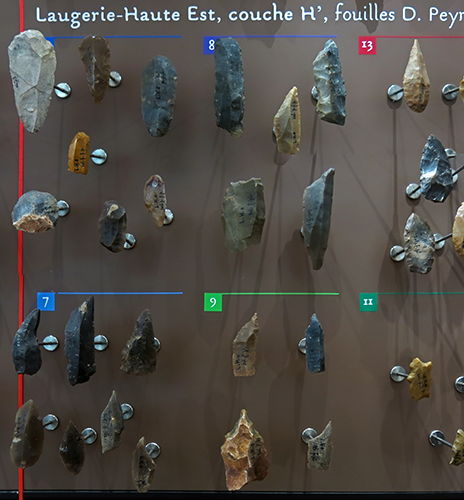
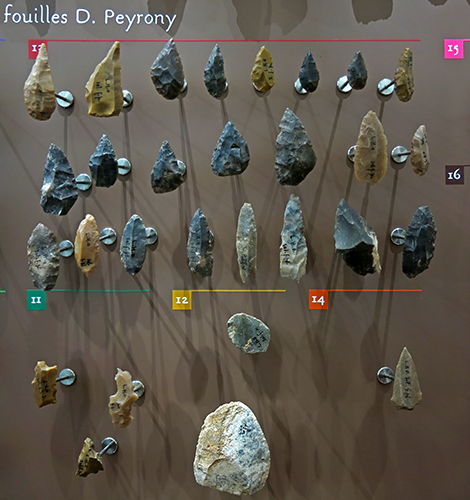
Laugerie Haute
The display is labelled as Laugerie Haute Est, Couche H', excavations of D. Peyrony. However most of the tools bear the inscription L.H.o. sol.p.F.p. or sol.f.pl., and thus come from Laugerie Haute West. The grattoir in the left hand photograph, top row, third from left, is labelled L.H.E.
■ 6: Grattoirs, scrapers on the end of a blade
■ 7: Burins
■ 8: Retouched tools
■ 9: Perçoirs becs, drills/borers
■ 11: Notched/denticulated tools
■ 12: Racloirs/raclettes, side scrapers and small, often round scrapers
■ 13: Armatures, tools
■ 14: Composite tools
Photo: Don Hitchcock 2014
Source: Originals , Le Musée National de Préhistoire, Les Eyzies-de-Tayac

Laugerie Haute
The display is labelled as Laugerie Haute Est, Couche H', excavations of D. Peyrony. However most of the tools bear the inscription L.H.o. sol.p.F.p. or sol.f.pl., and thus come from Laugerie Haute West.
Note, however, that the first of the bone tools is labelled as L.H.E. sol.p.f.p.
■ 13: Armatures, tools
■ 14: Composite tools
■ 15: Special tools
■ 16: Bone industry
Photo: Don Hitchcock 2014
Source: Originals , Le Musée National de Préhistoire, Les Eyzies-de-Tayac

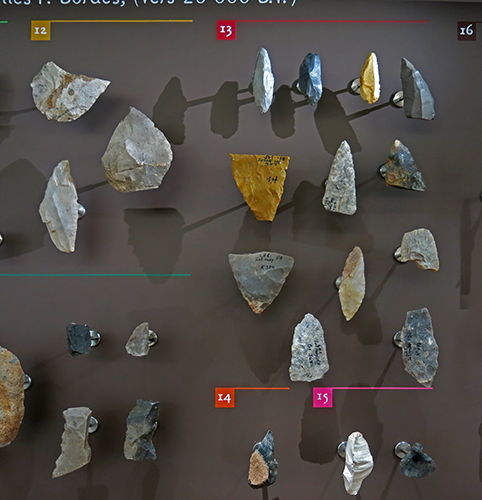
Laugerie Haute Est, layers 29-30, excavations of F. Bordes, around 20 000 BP
Some of the tools are labelled as L.H.E. Sol. moy. F5, that is the middle Solutrean.
■ 6: Grattoirs, scrapers on the end of a blade
■ 7: Burins
■ 8: Retouched tools
■ 9: Perçoirs becs, drills/borers
■ 10: Microliths
■ 11: Notched/denticulated tools
■ 12: Racloirs/raclettes, side scrapers and small, often round scrapers
■ 13: Armatures, tools
■ 14: Composite tools
■ 15: Special tools
Photo: Don Hitchcock 2014
Source: Originals , Le Musée National de Préhistoire, Les Eyzies-de-Tayac

Laugerie Haute Est, layers 29-30, excavations of F. Bordes, around 20 000 BP
Some of the tools are labelled as L.H.E. Sol. moy. F5, that is the middle Solutrean.
The first of the bone tools is labelled L.H.o. Sol. s.f.l. in the handwriting of Peyrony.
■ 13: Armatures, tools
■ 14: Composite tools
■ 15: Special tools
■ 16: Bone industry
Photo: Don Hitchcock 2014
Source: Originals , Le Musée National de Préhistoire, Les Eyzies-de-Tayac
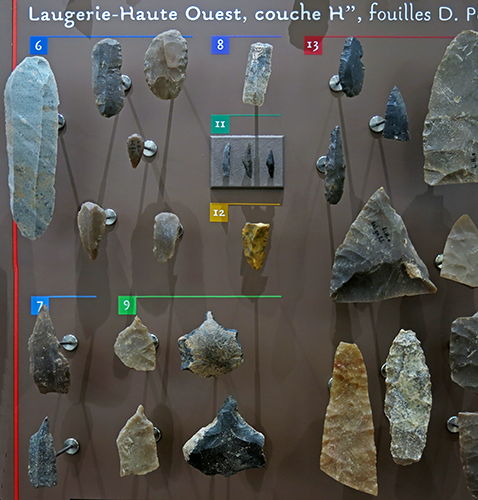

Laugerie Haute Ouest, Layer H'', excavations of Peyrony, 20 000 BP.
Some tools are labelled L.H.o. Sol.f.l.
■ 6: Grattoirs, scrapers on the end of a blade
■ 7: Burins
■ 8: Retouched tools
■ 9: Perçoirs becs, drills/borers
■ 11: Notched/denticulated tools
■ 12: Racloirs/raclettes, side scrapers and small, often round scrapers
■ 13: Armatures, tools
Photo: Don Hitchcock 2014
Source: Originals , Le Musée National de Préhistoire, Les Eyzies-de-Tayac
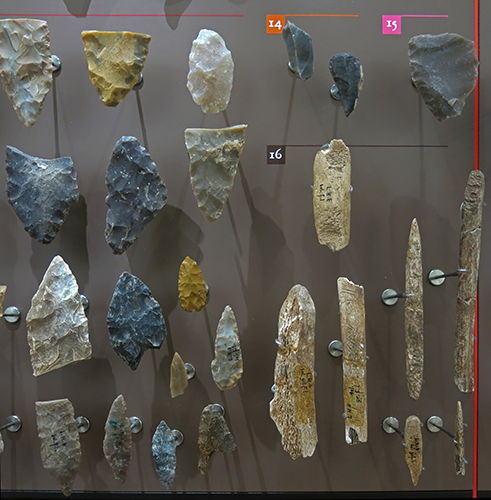
Laugerie Haute Ouest, Layer H'', excavations of Peyrony, 20 000 BP.
Some tools are labelled L.H.o. Sol.f.l.
The characteristic damage caused by use as a retoucher is apparent on the first bone or antler tool at 16.
■ 13: Armatures, tools
■ 14: Composite tools
■ 15: Special tools
■ 16: Bone industry
Photo: Don Hitchcock 2014
Source: Originals , Le Musée National de Préhistoire, Les Eyzies-de-Tayac
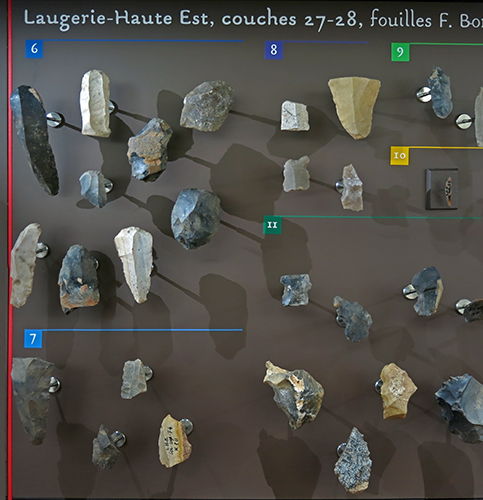
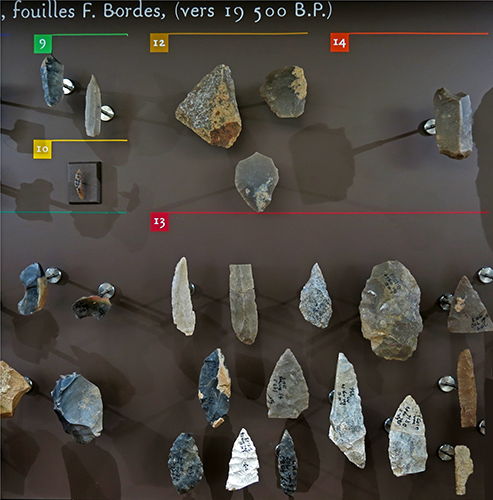
Laugerie Haute Est, Layers 27-28, excavations of F. Bordes, about 19 500 BP.
Some tools are labelled L.H.E. Sol. sup. F4.
■ 6: Grattoirs, scrapers on the end of a blade
■ 7: Burins
■ 8: Retouched tools
■ 9: Perçoirs becs, drills/borers
■ 10: Microliths
■ 11: Notched/denticulated tools
■ 12: Racloirs/raclettes, side scrapers and small, often round scrapers
■ 13: Armatures, tools
■ 14: Composite tools
Photo: Don Hitchcock 2014
Source: Originals , Le Musée National de Préhistoire, Les Eyzies-de-Tayac
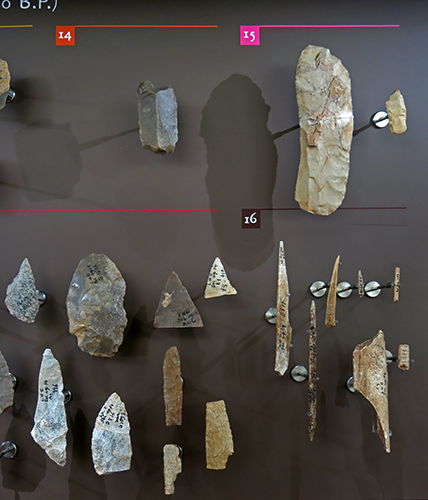
Laugerie Haute Est, Layers 27-28, excavations of F. Bordes, about 19 500 BP.
Some tools are labelled L.H.E. Sol. sup. F4.
■ 13: Armatures, tools
■ 14: Composite tools
■ 15: Special tools
■ 16: Bone industry
Photo: Don Hitchcock 2014
Source: Originals , Le Musée National de Préhistoire, Les Eyzies-de-Tayac
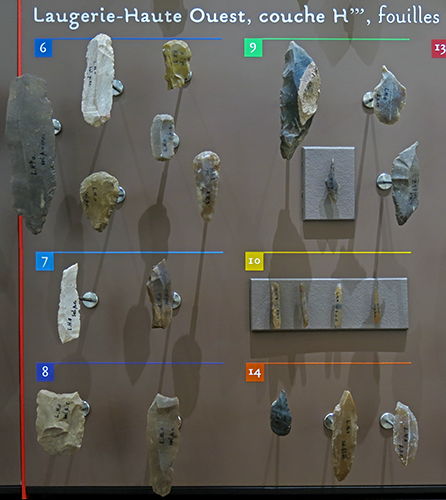
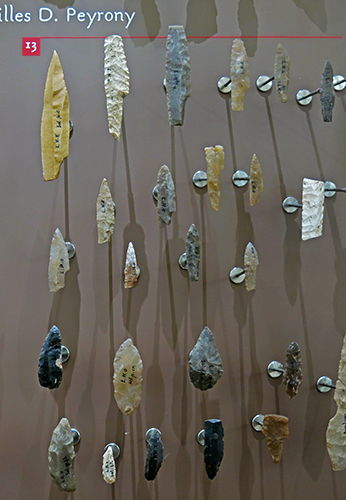
Laugerie Haute Ouest, Layer H'', excavations of Peyrony, 20 000 BP.
Some tools are labelled L.H.o sol.p.cr. or L.H.o sol.p.c.
The first pointe à cran at 13 is labelled as L.H.E. Sol.p.c.
■ 6: Grattoirs, scrapers on the end of a blade
■ 7: Burins
■ 8: Retouched tools
■ 9: Perçoirs becs, drills/borers
■ 10: Microliths
■ 13: Armatures, tools
■ 14: Composite tools
Photo: Don Hitchcock 2014
Source: Originals , Le Musée National de Préhistoire, Les Eyzies-de-Tayac
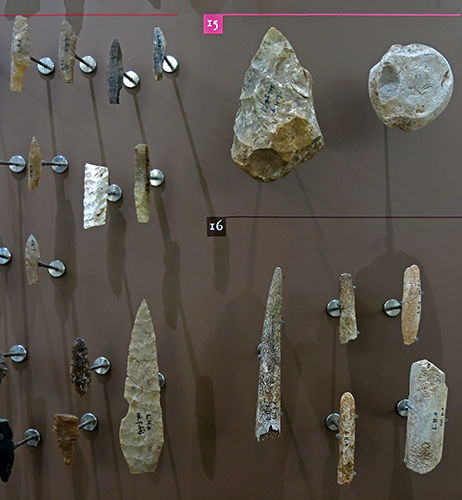
Laugerie Haute Ouest, Layer H'', excavations of Peyrony, 20 000 BP.
Some tools are labelled L.H.o sol.p.c.
■ 13: Armatures, tools
■ 15: Special tools
■ 16: Bone industry
Photo: Don Hitchcock 2014
Source: Originals , Le Musée National de Préhistoire, Les Eyzies-de-Tayac
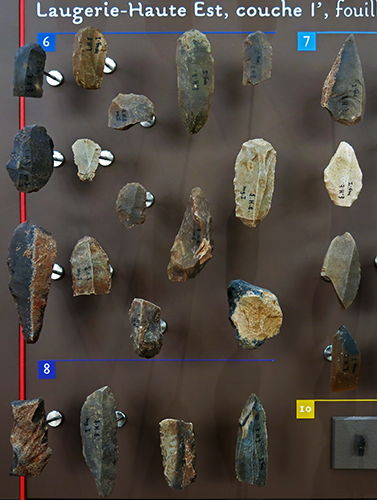
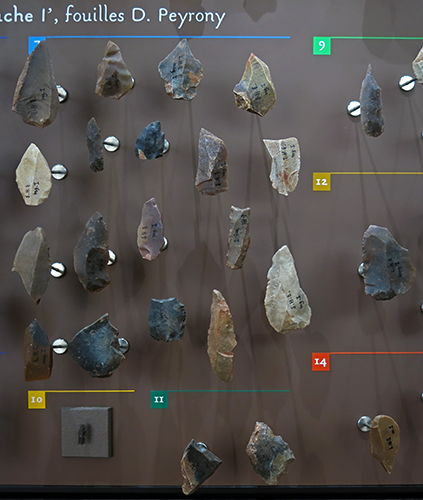
Laugerie Haute Est, Layer I', excavations of D. Peyrony.
Some tools are labelled L.H.E. mg. I.
■ 6: Grattoirs, scrapers on the end of a blade
■ 7: Burins
■ 8: Retouched tools
■ 9: Perçoirs becs, drills/borers
■ 10: Microliths
■ 11: Notched/denticulated tools
■ 12: Racloirs/raclettes, side scrapers and small, often round scrapers
■ 14: Composite tools
Photo: Don Hitchcock 2014
Source: Originals , Le Musée National de Préhistoire, Les Eyzies-de-Tayac

Laugerie Haute Est, Layer I', excavations of D. Peyrony.
Some tools are labelled L.H.E. mg. I. Note the tiny eyed needle on the grey plaque, and the tiny perçoir or awl above the yellow line which is small and sharp enough to have made the hole.
■ 9: Perçoirs becs, drills/borers
■ 12: Racloirs/raclettes, side scrapers and small, often round scrapers
■ 14: Composite tools
■ 15: Special tools
■ 16: Bone industry
Photo: Don Hitchcock 2014
Source: Originals , Le Musée National de Préhistoire, Les Eyzies-de-Tayac
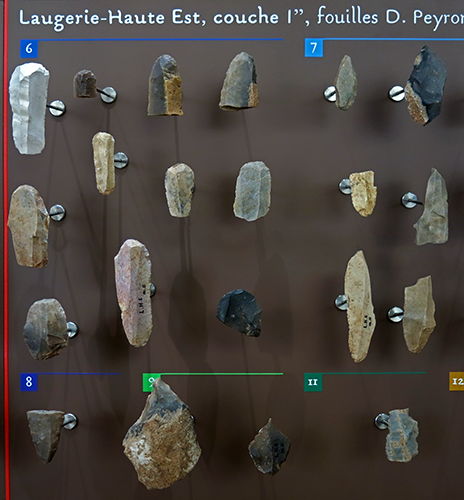
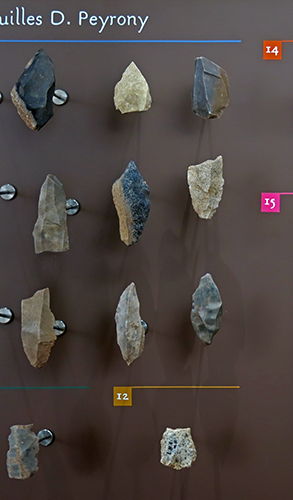
Laugerie Haute Est, Layer I'', excavations of D. Peyrony, 16 000 BP.
Some tools are labelled L.H.E. m.II.
■ 6: Grattoirs, scrapers on the end of a blade
■ 7: Burins
■ 8: Retouched tools
■ 9: Perçoirs becs, drills/borers
■ 11: Notched/denticulated tools
■ 12: Racloirs/raclettes, side scrapers and small, often round scrapers
Photo: Don Hitchcock 2014
Source: Originals , Le Musée National de Préhistoire, Les Eyzies-de-Tayac
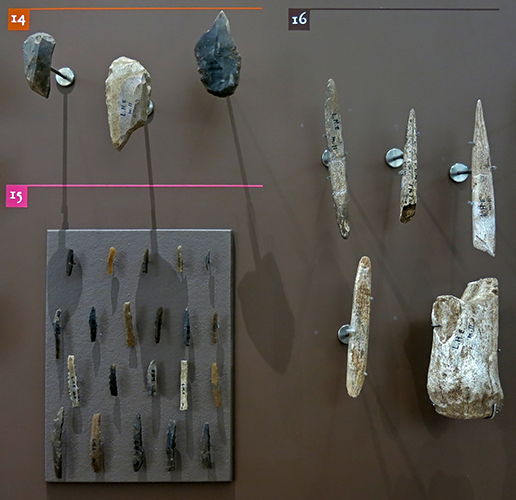
Laugerie Haute Est, Layer I'', excavations of D. Peyrony, 16 000 BP.
Some tools are labelled L.H.E. m.II.
■ 14: Composite tools
■ 15: Special tools
■ 16: Bone industry
Photo: Don Hitchcock 2014
Source: Originals , Le Musée National de Préhistoire, Les Eyzies-de-Tayac
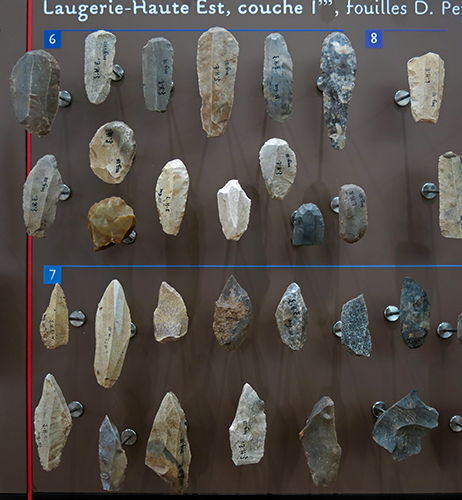
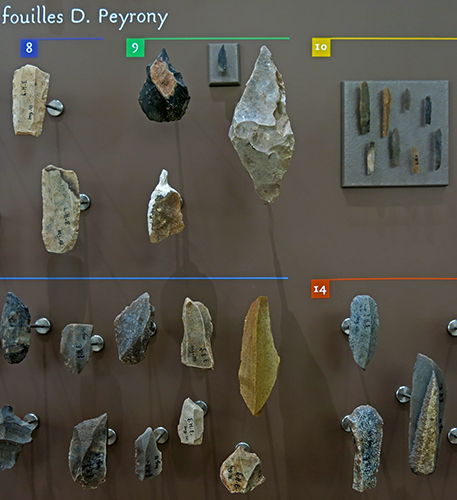
Laugerie Haute Est, Layer I'', excavations of D. Peyrony, 16 000 BP.
Some tools are labelled L.H.E. mg.III.
■ 6: Grattoirs, scrapers on the end of a blade
■ 7: Burins
■ 8: Retouched tools
■ 9: Perçoirs becs, drills/borers
■ 10: Microliths
■ 14: Composite tools
Photo: Don Hitchcock 2014
Source: Originals , Le Musée National de Préhistoire, Les Eyzies-de-Tayac
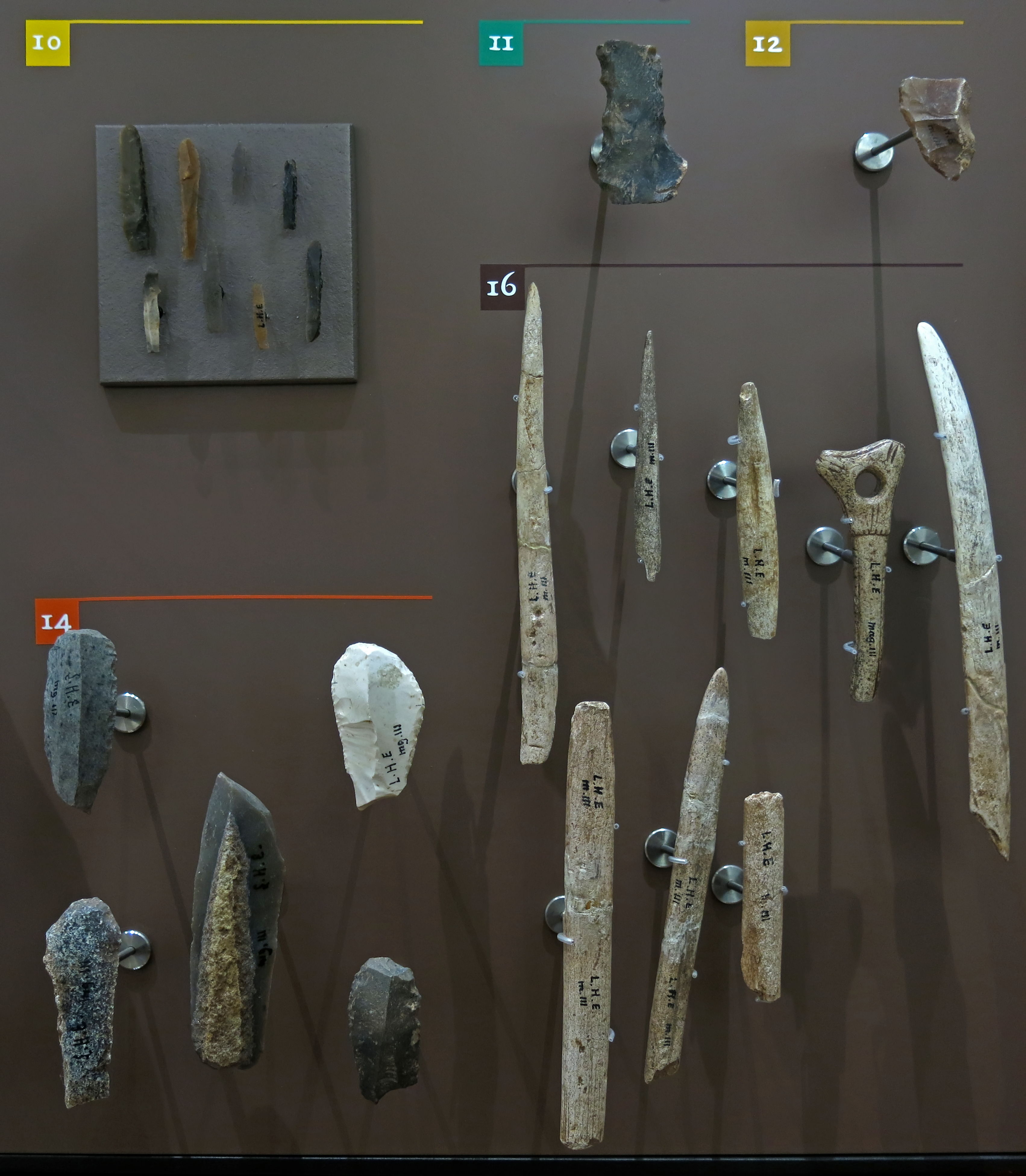
Laugerie Haute Est, Layer I''', excavations of D. Peyrony, 15 000 BP.
Some tools are labelled L.H.E. mg.III.
■ 10: Microliths
■ 11: Notched/denticulated tools
■ 12: Racloirs/raclettes, side scrapers and small, often round scrapers
■ 14: Composite tools
■ 16: Bone industry
Photo: Don Hitchcock 2014
Source: Originals , Le Musée National de Préhistoire, Les Eyzies-de-Tayac
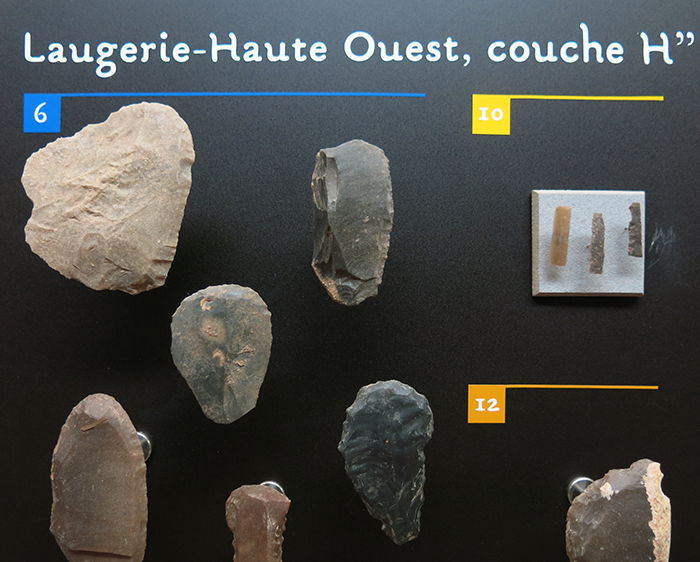
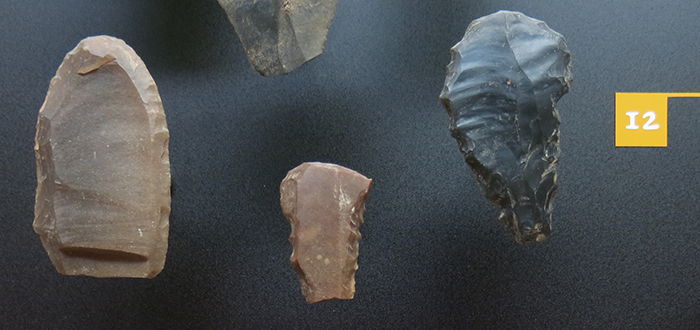
Laugerie Haute Ouest, Layer H'', excavations of Peyrony, 20 000 BP.
■ 6: Grattoirs, scrapers on the end of a blade
■ 10: Microliths
■ 12: Racloirs/raclettes, side scrapers and small, often round scrapers
Photo: Don Hitchcock 2014
Source: Originals , Le Musée National de Préhistoire, Les Eyzies-de-Tayac

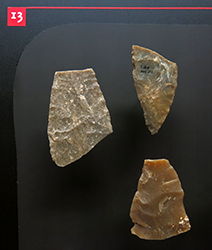
Laugerie Haute Ouest, Layer H'', excavations of Peyrony, 20 000 BP.
■ 7: Burins
■ 8: Retouched tools
■ 9: Perçoirs becs, drills/borers
■ 13: Armatures, tools
Photo: Don Hitchcock 2014
Source: Originals , Le Musée National de Préhistoire, Les Eyzies-de-Tayac
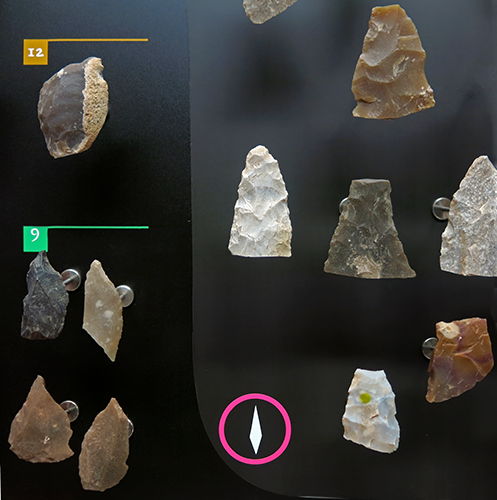
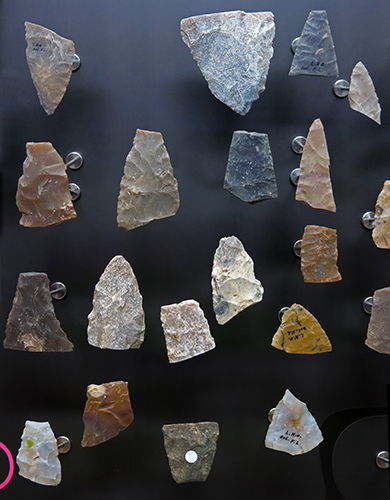

Laugerie Haute Ouest, Layer H'', excavations of Peyrony, 20 000 BP.
Left photo:
■ 12: Racloir
■ 9: Perçoirs becs, drills/borers
others are:
■ 13: Armatures, tools
Centre and right photos:
■ 13: Armatures, tools
Some tools are labelled L.H.o. Sol. F.L.
Photo: Don Hitchcock 2014
Source: Originals , Le Musée National de Préhistoire, Les Eyzies-de-Tayac
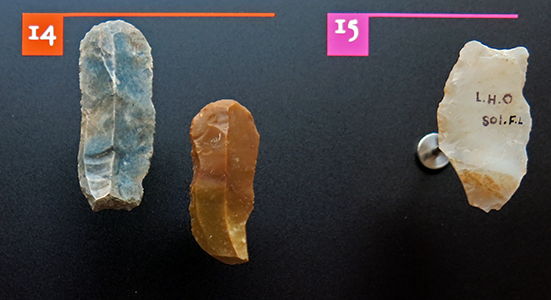
Laugerie Haute Ouest, Layer H'', excavations of Peyrony, 20 000 BP.
■ 14: Composite tools
■ 15: Special tools
Photo: Don Hitchcock 2014
Source: Originals , Le Musée National de Préhistoire, Les Eyzies-de-Tayac
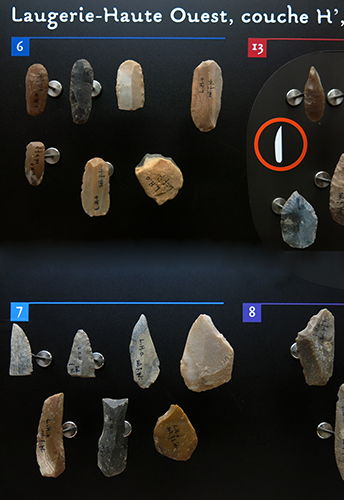
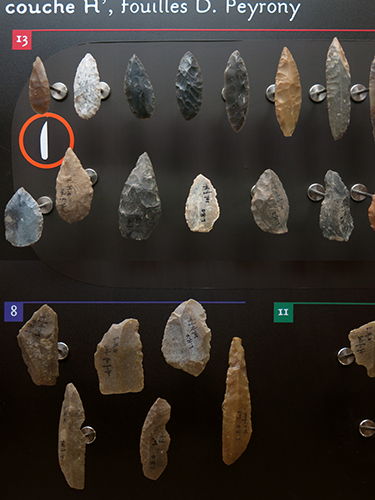
Laugerie Haute Ouest, Layer H', excavations of D. Peyrony, 20 500 BP.
■ 6: Grattoirs, scrapers on the end of a blade
■ 7: Burins
■ 8: Retouched tools
■ 11: Notched/denticulated tools
■ 13: Armatures, tools
Some tools are labelled L.H.o. Sol.f.l.
Photo: Don Hitchcock 2014
Source: Originals , Le Musée National de Préhistoire, Les Eyzies-de-Tayac
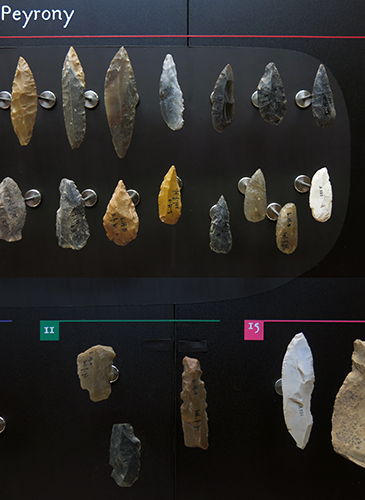
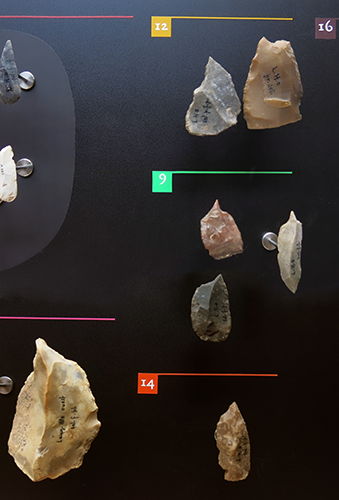
Laugerie Haute Ouest, Layer H', excavations of D. Peyrony, 20 500 BP.
■ 9: Perçoirs becs, drills/borers
■ 11: Notched/denticulated tools
■ 12: Racloirs/raclettes, side scrapers and small, often round scrapers
■ 13: Armatures, tools
■ 14: Composite tools
■ 15: Special tools
Some tools are labelled L.H.o. Sol.f.pl.
Photo: Don Hitchcock 2014
Source: Originals , Le Musée National de Préhistoire, Les Eyzies-de-Tayac
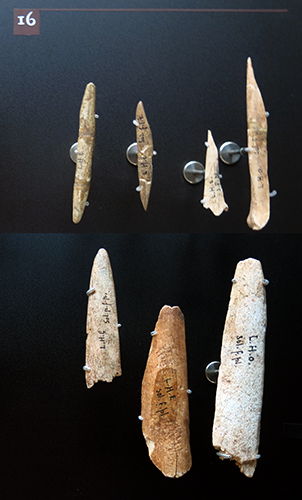
Laugerie Haute Ouest, Layer H', excavations of D. Peyrony, 20 500 BP.
■ 16: Bone industry
Some tools are labelled L.H.o. Sol.f.pl.
Three of these bone tools are labelled as L.H.E., that is from Laugerie Haute Est.
Photo: Don Hitchcock 2014
Source: Originals , Le Musée National de Préhistoire, Les Eyzies-de-Tayac
The specimens shown here, all from Laugerie Haute, are lanceolate pieces of flint, carefully shaped by repeated chippings into a flattish, long, acute-ovate form, with pointed ends and somewhat sharp edges. They are all from Laugerie Haute. The resemblance between these neatly made flint implements and some found in Denmark is very remarkable; hence these much-chipped and symmetrical forms are sometimes spoken of as belonging to the 'Scandinavian Type.'
1. Light-grey; glazed.
2. Dark-grey; glazed.
3. Chalcedonic flint, somewhat weathered; one end broader than the other.
4. Darkish-grey; much weathered and mottled, chiefly on one face. More oval than the others.
5. Narrow, neat, highly finished, nearly smooth; broadest at its lowest third; mottled light and dark brown; glazed.
6. Small, retaining curve of the original flake from which it has been worked; grey, slightly glazed.
7. Fragment, retaining the face of the original flake on one side; dark grey, glazed and weathered, showing fine grey mottling, especially on the convex face.
8. Fragment. Worked on both faces; grey; glazed.
9. Fragment. Dark-grey, coarse flint; glazed.
10. Small; somewhat irregular in outline; grey; glazed.
11. Long and narrow, symmetrical, broadest towards one end; light-grey flint, much weathered, freely flecked with white, and the edges white and opaque.
12. Long, narrow, less regularly lanceolate than the others, tapering nearly equally at the two ends; one side formed of the original face of the flake. Brownish-grey flint, highly glazed, and much whitened by weathering, especially on the flat face.
Source and text: Lartet and Christy (1875)
Proximal source: archive.org
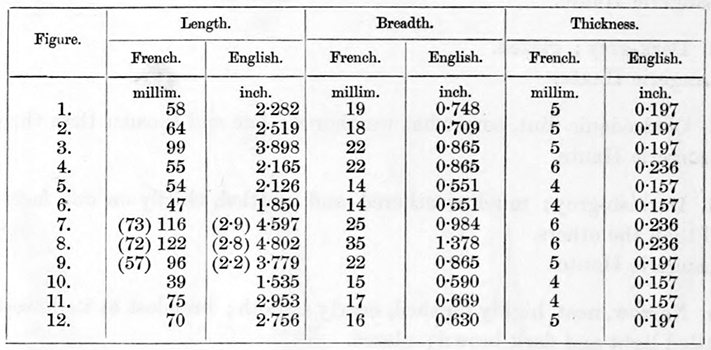
Dimensions of the artefacts above.
Note that Figures 7, 8, and 9 being fragments, the measurements in brackets give the actual length of the pieces, and the estimated length of the specimens when perfect is placed in the column for comparison with that of the others.
Source and text: Lartet and Christy (1875)
Proximal source: https://archive.org/
This plate represents twelve flint artefacts from Laugerie Haute, all of which have been thought to have one end prepared for fastening in a stick or shaft. It is not, however, always easy to decide which was really the fixed end; for, though some of these specimens may have been lance-heads, many bear evidence of use on one or both edges of what seems at first sight the butt end, whilst the blade-like and unused portion is still quite sharp at the point and edges.
In 3. the butt is boldly and nearly equally notched on either side; and in
10., though broken, it seems to have been symmetrically chipped to a tapering flattish point, like that of the other extremity of the specimen. In 8. and 12. also both ends of the instrument have been pointed; but one end is more contracted than the other, having been much reduced at the edges.
In all the others one end has been narrowed (with or without tapering) by the removal of a large portion of one edge. Whether this was done for insertion in a handle, or whether the diminution in width was not rather the result of wear, are questions not easily determined. In some instances it seems probable that the part of the flake which still retains its sharp edges has been protected by insertion in a handle, while the other part has been used for cutting, or rather for scraping: see 1. and 2. below.
The care with which many of them have been chipped (not well shown by the figures) has given them a character approximating to that of the 'Scandinavian'.
All these artefacts are from Laugerie Haute; but the same forms occur also elsewhere in considerable numbers.
1. Light-brown flint, weathered grey. Long, narrow; one-third lanceolate; the rest semicylindrical. This has been a part of a flake dressed at one end by
chipping into a plano-convex tapering shape; at the other it is narrower, tapering, and subquadrate in section. There is clear evidence of wear on both edges of
the semicylindrical portion, which hence seems to have been reduced in width by having been used as a scraper, chiefly on one side, whilst the blade-like portion (figured uppermost) was fixed in a haft.
2. Greyish-brown flint, weathered. A flake but little modified. One half
has been narrowed by rough usage, perhaps as a scraper, on one edge, and roughly pointed by chipping at the end. At the other end also the flake has been chipped towards the point; but this has been broken off, and is restored on the drawing.
3. Dark olive-grey flint, somewhat glazed ; spearhead-shaped, but broken at the top. Carefully chipped on both faces, and indented by a bold angular notch at each side of the broad end.
4. A flake of whitish flint, slightly glazed; shortened by fracture. By careful chipping on one face and at the edges it has been given a long lanceolate form, with one-third narrowed by wear on one edge. Marks of use are also traceable along the other edge of the narrow part of the specimen, and on both edges of the broad end.
5. A thin flake of flint, chipped into a lanceolate shape, and narrowed for nearly half its length by one edge having been crushed and splintered away by use. An almost saw-like jaggedness (not well shown in the drawing), referable to
wear, marks the other edge of the narrow portion. The flint, originally light- brown and translucent, has been subsequently mottled by a white opacity, especially on the flat side and all along the edges.
6. Dark-grey narrow flake of flint, somewhat glazed; sharpened at one end, by careful chipping on the ridge and its slopes, into an arrowhead-shape (point broken off); one edge also has been minutely chipped to produce the symmetrical outline ; the other end (shortened by fracture) has been narrowed by breakage of the edges, probably from use, chiefly on one side. (The drawing does not well show the delicate chipping of the rounded back of the tapering point.)
7. Small flake of grey flint, glazed; pointed by chipping on the ridge-face and edges, like 6., but with less parallel sides. The broken end shows a notch (not well defined in the drawing), either coarsely chipped for a butt, or worn out by use, the sharp end having been, in that case, fixed in a handle.
8. Light-grey coarse-grained flint; lanceolate; rather roughly chipped on both faces; the ends taper almost symmetrically, but one more rapidly than the other; and each has a blunt point. The edges seem throughout to have been fashioned by the general chipping of the instrument; but at the narrow end the chipping may have been subsequent to, or even produced by, wear, better evidence of which is traceable in the notches where the narrowed
portion begins.
9. Light-brown translucent flint, mottled all over with the opake whiteness due to weathering, especially on the flat side, and at the edges and ends. This is a fragment of a narrow lanceolate implement, very neatly and symmetrically made from a flake by careful chipping of the ridge-face, which has been reduced to a flat-arched outline in the broader part, and is subtriangular where it is narrower.
The reduction in breadth has been caused most probably by the use of one edge as a scraper. Very slight indications of wear occur elsewhere on the edges. The drawing does not well represent the numerous parallel flakings of this well-chipped implement.
10. Dark-grey flint, with a lighter-grey portion showing Sponge-spicules and other small organisms; glazed. A broad lance-head (?), worked by bold chipping on both faces. One end broken away.
11. The tapering end of a flake of opaque-white flint, minutely chipped on
the edges into a sharp symmetrical point, and towards the notched end chipped over the ridge and slopes. The commencement only of the contracted portion remains, owing to fracture; but the notch probably belonged to a one-sided scraper, broken off close to the haft, in which the lancet-shaped end was inserted.
12. Light-brown translucent flint, weathered (especially on one face). This is a large portion of a long blade-like instrument, with nearly parallel sides. It is broken off short at one end, and has a symmetrical, sharply tapering, flattish point at the other. Both faces have been reduced by free chipping; the face figured in the drawing is rather more convex than the other. The parallel edges of the broad part show no signs of having been used, but the angular end has a peculiar crushed and shivered condition due to its having been worn down by the use of its edges, which are affected mostly on alternate sides, the upper side on the right of the figure, and the under side on the left hand. Under these circumstances, we may suppose that the blade-like portion was held in the hand or fixed in a handle.
Source and text: Lartet and Christy (1875)
Proximal source: archive.org
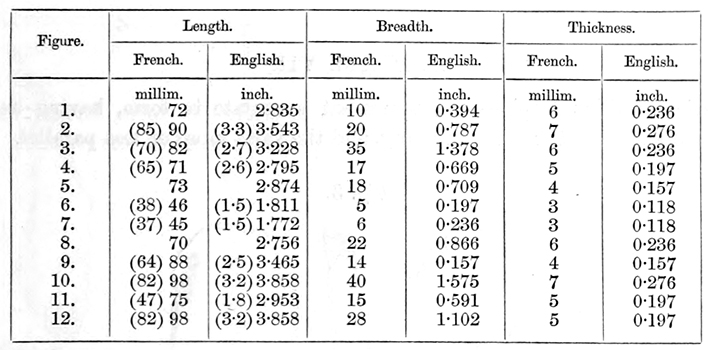
In this table, for the specimens that have been broken, the actual measurements are placed in brackets, and the estimated length is entered in the column, for comparison with the other specimens.
Source and text: Lartet and Christy (1875)
Proximal source: https://archive.org/

Figures 1a and 1b represent the two faces of an implement of whitish flint, chipped into shape, and used for scraping. The blade-like portion has been set in a handle or held in the hand. The other end has been much worn by scraping with the two sides alternately, whereby the narrow end has been tapered.
Figure 2 is a neat flake of grey flint, that has been worn away along the middle part of one edge by scraping. The sharp end has probably been set in a handle.
Source and text: Lartet and Christy (1875)
Proximal source: https://archive.org/
References
- Bordes F., 1978: Le Protomagdalénien de Laugerie-Haute-Est (fouilles F. Bordes)Bulletin de la Société préhistorique française, tome 75, n°11-12, 1978. Études et Travaux. pp. 501-521.
- Lartet, E., Christy H.,1875: Reliquiae aquitanicae : being contributions to the archaeology and palaeontology of Pèrigord and the adjoining provinces of Southern France, London: Williams, 1875
- Peyrony, D. et E., 1938: Laugerie Haute près des Eyzies (Dordogne), Paris, Masson, 1938, pp 9-10 , Fig 2 (Archives de l'Institut de Paléontologie humaine, No 19)
Back to Don's Maps
 Back to Archaeological Sites
Back to Archaeological Sites

